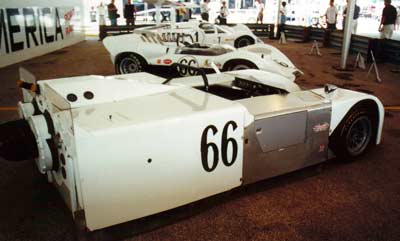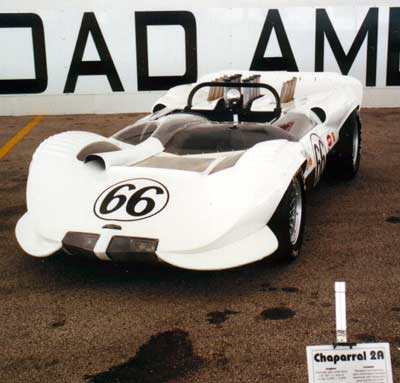INSIDE
RACING
T E C H N O L O G Y
IRT Home
IRT Home
News Page
Contents Page
Newsletter &
Books
email Paul
Hall/Redman Interview, Page 2
The Brian Redman International Challenge at Road America, Jim Hall Grand Marshal.

I continued the conversation by asking about shock absorbers, more correctly referred to as dampers.
PH: "At that same time what was going on with shocks? Did you have much choice? Both Brian and Jim look at each other and chuckle.
BR: "Konis."
JH: "We were running Konis too, I think. We tried some Armstrongs I think. They had an adjustment on them. Compression maybe?" He looked at Brian.
BR: "Yes, it was a compression adjustment. But people didn't take much notice of shocks at that time."
JH: "Well, we were running on light enough springs and small enough tires that there really wasn't much of a problem. The cars were more like passenger cars than the racecars of today. With those light spring rates the tires would ride over the bumps."
BR: "The tracks were much bumpier then. In those days most of the tracks were very bumpy. Formula 1 cars and Indy cars of today can't tolerate tracks that bumpy."
JH: "The tires stayed in contact with the gound most of the time and it didn't take a whole lot of damping to do that. We learned as the tires got stiffer that you had to back off on the rebound forces to let the wheel come back down and make sure the tire didn't jump up off the ground. But it depends on tire stiffness. Damping is a little bit black art anyway. Today it might not be but I'm talking about the 60s."
BR: "In 1969 on the Chevron cars we started using Bilsteins. They worked a lot better."
PH: "That was a gas-pressure shock."
JH: "That made a lot of difference, the gas shock. Before that the shocks used to overheat and they went away."
BR: "These days the teams have got guys who do nothing but make shock changes."
JH: "Yeah, all they do is change little features in the shocks all the time. Well, they've got good data. They go to test rigs where they can bounce the wheels at all the different frequencies. They can look at track data and tell what the hop frequency is at each track. They can duplicate that at these test rigs and start jiggling around with the shocks until you get the thing damped out. It's kind of the same thing that's happening with engines. It's not that everybody's so much smarter than they used to be but they can measure everything and tell what's doing on. They can fiddle with the fuel and spark and make the engine better."
PH: "When you had that first car built by Troutman and Barnes, what were the ideas you had built into that car that made it different from the cars you'd been buying from manufacturers?"
JH: "I'll tell you where I was at that point. Hap Sharp was a friend of mine and a customer, really. I sold him quite a few cars. He always tried to get the latest cars and I was similar. We worked a differenct path. He made his inroads at Cooper and I did the same at Lotus. I could talk to Colin [Chapman] and try to get the car that I wanted. Hap had the same relationship with John Cooper. But we realized that when we went to the West Coast races Jack Brabham and Sterling Moss would have later model cars than the one we just bought. Not only could they drive better but they had a better car.
"We figured this wasn't going to change and I thought I might be able to do better. I think I talked to Troutman at Riverside and he said they were going to build a car incorporating all the things they learned at Scarab. They wanted to build a lightweight, Chevy-powered racecar. I told them I was interested. I visited them at their shop in Culver City. They had the car layed out. They moved the weight back a long ways and it was going to be a simple car, easy to maintain, lightweight, stop good, with big tires.
"That sounded like a really good combination to me. We were running against Climax-engined cars with 2.5 liter, four-cylinder cars. And the price wasn't bad. I thought it was quite economical. So I told them, if they needed something to get going, I'll buy one. That's the way that happened. I got the first one and later another one."
PH: "So it was already designed, the chassis and suspension geometry?"
JH: "Yeah, I didn't hardly have anything to do with it. I made some comments about a couple of things. But it was basically their design.
PH: "As you started making the other cars and getting some downforce on them, how did you maintain the balance of the cars?"
JH: "That's a development. If you look at the history of the thing it's really quite simple. I had some experience and I started doing some driving for Chevrolet. I drove the Corvair for them. They had a lot of trouble with that car. They wanted a guy that wouldn't turn it over. I drove the Corvair a lot. I took expert witnesses for rides-maybe 25 of them-so they would understand how the car worked.
"We'd drive around the skidpad and take air out of the rear tires until the rim touched the ground. That was one of the allegations in the lawsuits that, if you had low tire pressure, it would flip. You cold flip it but you had to work at it."
PH: "That was the swing-axle car?"
JH: "Right, '63 and earlier."
PH: "Nobody wanted to notice that VW was selling a car with the same suspension."
JH: "That's right. When Chevrolet designed that car they said lets build a simple car. What's the model? Well if it works for VW it should work for us. There were some problems with that design but then they fixed it. That's where I got involved. They looked at our car and said, 'Gee you don't have that trouble. What are you doing?'
"Well we were doing it different with four-bar links and rear weight bias same as the Corvair. That' s how my relationship with Chevrolet started. I did a lot of driving and I got to instrument the car. I knew what the car was doing. It wasn't just what I thought, I knew. I knew."
PH: "That had to help, just driving the car and looking at the data."
JH: "That's right. We compared the Corvair to Formula Jr.s and to our car. You know a Formula Jr was really a high cornering power car. It didn't have any power but it was a good little race car. We compared all that stuff and that was really beneficial to me.
"So when we first built the Chaparral II, I ran it for a couple of months with no body on it, just the tub. We hadn't built the body yet. We were still claying up the model.
"I was running the tub around to try to get some reliability and find out if it would handle. When we put the body on it, all of a sudden it slowed down. We thought, Gee it's supposed to be faster with a body, slicker aerodynamically.
"Then we realized the front end had a lot of lift. At 120 mph you could move the steering wheel a little each way and it would go straight on. So I did my first instrumentation myself.
"What I did was just wrap a piece of welding rod around
the A-arm, drilled a hole in the fender, marked it every half
inch, and counted marks as I drove the car. I'd run it down a
straight at 60, 80, 100 mph. So I had a curve, a lift curve.
I knew the spring rates so I knew the lift force.
"Then we put that snowplow on the front and I ran at Riverside
the first time. That was late '63. We took it to Nasau and Laguna
Seca. I had mechanicals at all three places. But it was quicker
by a lot than the other cars.

"That winter I ran it around the skidpad and it felt good, it cornered good. It was nicely balanced. And I thought, what you really want is a car that doesn't lift. You want it to be as good at 100 mph as it is at 40. So kept screwing around with it until I got it. I had the instrumentation, just the welding rod stuff.
"The other thing I had was a manometer with a bank of about 20 tubes. I just tapped the body everywhere and I had a polaroid camera mounted up front right near me with a cable release. I'd go 100 mph and take a picture. So I knew the pressure distribution and I started changing the body shape. I got it so it was a zero-lift car at 100 mph.
"But it wasn't worth a damn because it oversteered. That's when the light bulb went on. Right there! It was mid-winter 1963/64. I thought, Jesus, if I can get rid of 300 pounds of lift on the front, why don't I get it to push down. So we put the ducktail on and we started to get 2 or 3 hundred pounds of downforce in the back. Our lap times went down by 2 or 3 seconds. [Jim's leans forward and his voice goes up a notch. He's as excited now as if all this happened just last week.] In one week I dropped my own lap time at Rattlesnake Raceway by 3 seconds. That's a pretty big improvement."
The link to the third page is at the top.